How to Get Your Roommate to Stop Snoring
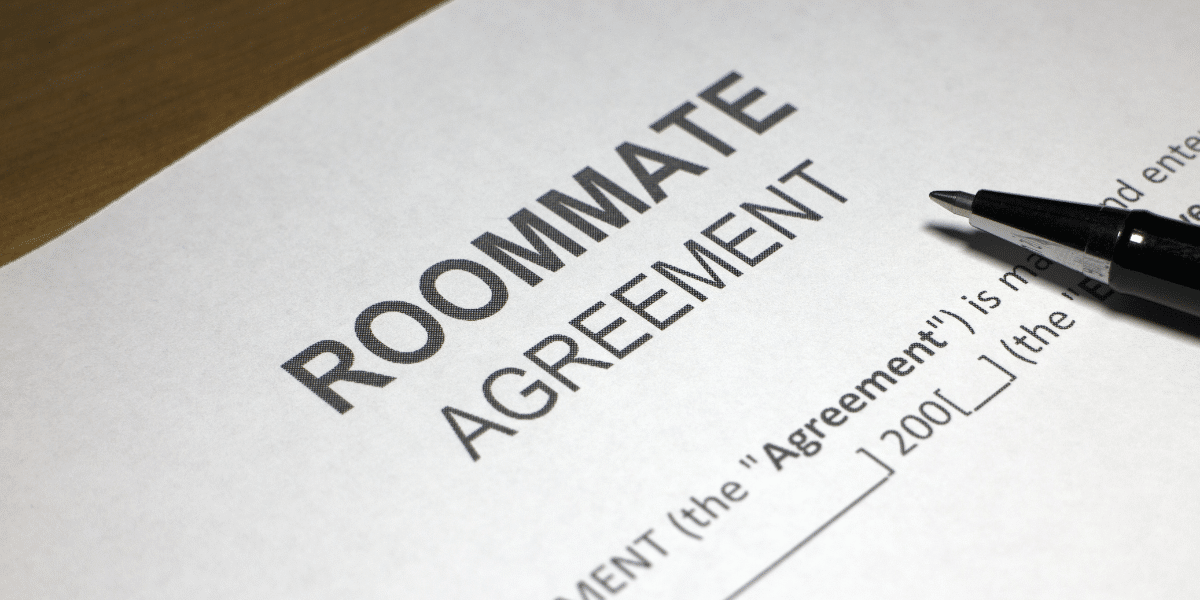
If you’re reading this, chances are you’re feeling frustrated, sleep deprived, and possibly even a little resentful towards your snoring roommate. Snoring can be a major nuisance, and it’s important to address the problem not only for your own sake, but for your roommate’s health as well.
Snoring can be caused by a variety of factors, including obesity, alcohol consumption, and sleep position. It can also be a sign of a more serious underlying health issue, such as sleep apnea. Regardless of the cause, it’s important to address the problem so that both you and your roommate can get a good night’s sleep.
But how do you go about solving this problem? It’s not always easy to bring up such a sensitive issue with a roommate, especially if you’ve been tolerating the snoring for a while. In this guide, we’ll walk you through the steps to take in order to get your roommate to stop snoring and finally get some much-needed rest. Let’s get started!
Step 1: Assessing the severity of the snoring
The first step in tackling the problem of a snoring roommate is to assess the severity of the issue. It’s important to determine whether the snoring is occasional or chronic, as this will help you figure out the best course of action.
There are a few different ways you can gather evidence about the snoring. One option is to record the snoring using a smartphone or other device. This can help you and your roommate listen to the sound and get a better understanding of the problem.
You could also keep a sleep diary, noting down how often the snoring occurs and how loudly it is. This can help you identify patterns and triggers for the snoring.
It’s also a good idea to observe your roommate’s sleep habits. Do they snore every night, or only sometimes? Do they snore more loudly when they sleep on their back or on their side? Gathering this information will be helpful when it comes to finding a solution.
In the next step, we’ll talk about how to approach your roommate about the snoring problem and work together to find a solution.
Remember, it’s important to approach this conversation with empathy and concern for your roommate’s health, rather than placing blame or getting angry. Stay tuned for more tips on how to have this difficult but necessary conversation.
Step 2: Explaining the problem to your roommate

Now that you’ve assessed the severity of your roommate’s snoring and gathered some evidence, it’s time to have a conversation about the problem.
It’s important to approach this conversation with empathy and concern for your roommate’s health, rather than placing blame or getting angry. Here are some tips for having this difficult but necessary conversation:
-
Start by explaining how the snoring is impacting you and your sleep. Emphasize the importance of good sleep for overall health and well-being, and explain how the snoring is disrupting your sleep and affecting your mood and productivity.
-
Avoid getting confrontational or accusatory. Instead, express your concern for your roommate’s health and well-being. Snoring can be a sign of a more serious underlying health issue, such as sleep apnea, and it’s important to address the problem for your roommate’s sake as well as your own.
-
Be willing to listen to your roommate’s perspective. They may have concerns or objections to addressing the snoring, and it’s important to understand their perspective and come to a solution that works for both of you.
-
Consider seeking the advice of a healthcare provider. If the snoring is chronic and disrupts your roommate’s sleep on a regular basis, it may be worth consulting a healthcare provider for further evaluation and treatment options.
Step 3: Finding a Solution
Once you’ve had a conversation with your roommate about the snoring problem, it’s time to start exploring solutions. Here are a few options to consider:
-
Lifestyle changes: There are a few lifestyle changes that may help reduce or eliminate snoring. These include losing weight, quitting smoking, and sleeping on the back rather than the stomach or side. Encourage your roommate to make these changes and see if it has any impact on the snoring.
-
Over-the-counter remedies: There are several over-the-counter products that claim to help reduce or eliminate snoring. These include nasal strips, throat sprays, and chin straps. Encourage your roommate to try a few different options and see what works best.
-
Consult a healthcare provider: If the snoring is chronic and disrupts your roommate’s sleep on a regular basis, it may be worth consulting a healthcare provider for further evaluation and treatment options. They may recommend a sleep study or prescribe medication to help alleviate the snoring.
It’s important to keep in mind that finding a solution to snoring may take some trial and error. Encourage your roommate to be patient and persistent in finding a solution that works for them.
In the meantime, there are a few things you can do to cope with your roommate’s snoring and try to get a good night’s sleep. In the next step, we’ll discuss some strategies for minimizing the impact of the snoring on your sleep.
Step 4: Coping with the snoring in the meantime
While you and your roommate work to find a permanent solution to the snoring problem, there are a few things you can do to minimize the impact of the snoring on your sleep. These may include:
-
Using earplugs: Earplugs can be an effective way to block out noise and get a better night’s sleep. There are many different types of earplugs available, so try a few different pairs to see what works best for you.
-
Using a white noise machine: A white noise machine can help to drown out the sound of snoring and create a more peaceful sleep environment. There are many different types of white noise machines available, including ones that you can play through a smartphone or other device.
-
Sleeping in a different room or on the couch: If the snoring is particularly loud or disruptive, you may want to consider finding a temporary solution, such as sleeping in a different room or on the couch. This can give you a break from the noise and allow you to get some much-needed rest.
Remember, it’s important to work with your roommate to find a long-term solution to the snoring problem. In the meantime, these strategies can help you get some much-needed rest and cope with the situation.
How to Block Out Snoring Without Earplugs?
If you don’t want to use earplugs to block out snoring, there are a few other options you can try:
1. Use a white noise machine: A white noise machine can help to drown out the sound of snoring and create a more peaceful sleep environment. There are many different types of white noise machines available, including ones that you can play through a smartphone or other device.
2. Sleep with a fan or air purifier: The sound of a fan or air purifier can help to mask the sound of snoring and create a more soothing sleep environment.
3. Try sleeping with a pillow over your head: If you’re comfortable sleeping with a pillow over your head, this can help to block out some of the noise. Just be sure to keep your head and neck in a comfortable position to avoid any neck pain.
Best Anti-Snoring Mouthpieces for Your Roommate
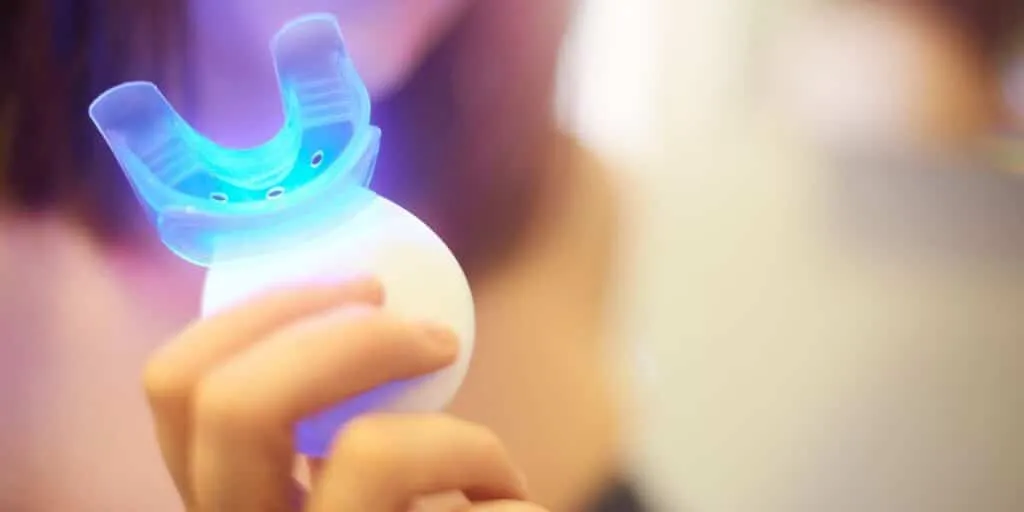
Anyone who snores will already be aware of how disruptive the problem can be, both for their own sleep and for those around them. When you choose a stop snoring mouthpiece, however, you need to select one that is comfortable enough to allow you to enjoy a good night’s rest, as getting quality sleep is essential to your well-being.
If you can stop snoring, your mind and body will be able to obtain the vital rest that it needs – enduring repeated nights of poor sleep can eventually have a serious effect on both your professional and personal life. One of the best stop snoring devices is an anti-snoring mouthpiece, and once you become used to wearing it, it can actually feel so comfortable that you forget that it’s there.
Stop snoring mouthpieces are also quite affordable, especially when compared to other available options, and they are not only effective at preventing snoring but also improve breathing too. The effects of long term snoring can be serious, and even life-threatening should the snoring be linked with sleep apnea, which can lead to strokes, hypertension, heart disease, and cancer. Those who suffer from impaired sleep are also putting themselves at risk every time they operate machinery or drive a vehicle.
How To Choose The Best Anti-Snoring Device?
Everyone who snores themselves or who lives with someone with the snoring problem knows how disruptive it can be to get a decent night’s sleep. However in your search for a way to resolve the problem you are likely to encounter a range of products all claiming to help, so how do you know which is right for you? A product which is uncomfortable or painful will just make it harder to get to sleep, and obtaining enough sleep is essential to your well-being and a major factor in the maintenance of good health.
Even if you sleep alone and are not at risk of disturbing others, your snoring will disturb your mind and body. Snoring keeps you in a state of alertness and this prevents you from getting adequate amounts of sleep to ensure good health. This, in turn, will lead to severe consequences for both your personal and professional life in the long term.
There are a great variety of products available for purchase today, all proven to stop snoring effectively, and most of these stop snoring mouthpieces are surprisingly comfortable, so much so that soon you’ll even forget you’re wearing one.
These anti snoring devices are also considerably more affordable than some of the other available options such as surgery or a CPAP machine, and they have another benefit in that they improve breathing too.
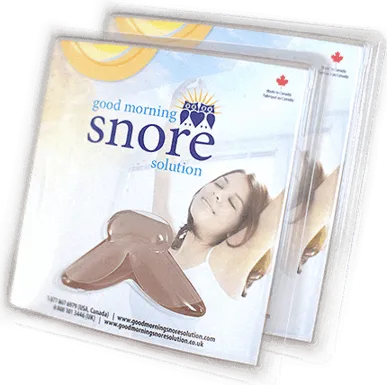
Ignoring your snoring problem is simply not a solution. It will never go away by itself and it can even have severe and even life-threatening effects, especially if you suffer from sleep apnea. Sufferers are at greater risk of all kinds of medical problems from cancer and heart disease to strokes and high blood pressure. Snorers are also putting themselves in danger if they use machinery or drive after a poor night’s sleep.
Manufacturers of these oral devices often claim that their product has over 90% effectiveness, however, there are even better devices out there with a rating of 98% for effectiveness, and these represent the best possible solution for snorers and those close to them.
When you compare the products featured on our site, bear in mind that any difference in a device’s satisfaction and effectiveness are based entirely on the individual use of each. If you click on each product you are interested in you can find a detailed review outlining customer opinions.
This will help when making a decision over which product to choose thanks to the study findings by experts and accurate estimates given. For example, one study was carried out with more than 130 snorers who used stop snoring mouthpieces and you can publicly view the results.
At the end of the study, more than 85% of those participating chose to continue using their oral device. A different study carried out in 2005 with 20 snorers who were issued with MADs found that these devices represented an effective treatment for snoring.
There are two types of oral device on the market today that represent a practical solution to snoring. These are:
-
MADs (Mandibular Advancement Devices)
-
TSDs (Tongue Stabilizing Devices)
While they may appear identical in fact there are many differences. Here we look at each one’s features and see how they can give you a good night’s rest.
Tongue Stabilizing Devices (TSDs)
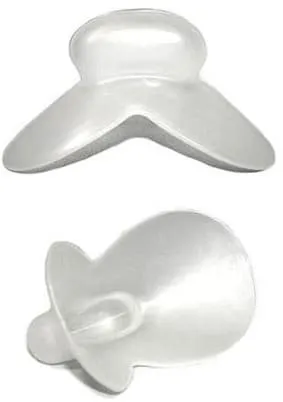
A TSD or tongue stabilizing device functions by holding the tongue in position in order to reduce or prevent snoring altogether. During sleep, the tongue and muscles around it relax, allowing it to fall backward into the throat. This causes blockages in the airways which causes the vibrations that result in snoring.
This can be prevented by wearing a device that holds the tongue in place, and this is the purpose of a TSD. It uses a vacuum to hold everything in the right place, thus preventing constriction of the airways by the tongue, keeping them open and your night noise-free.
Safety and Comfort

It is important that your anti-snoring device is both safe and comfortable to wear for it to be effective. A TSD allows the wearer to relax completely, with no need to bite down to keep it in position, and this is a great advantage compared to some other anti-snoring methods such as anti-snoring pillows which require the user to keep their head in a fixed position for it to be effective.
A TSD allows you to sleep in any position, except on your front, and it will still be effective. They are also manufactured from medical grade silicone which prevents irritation to the tongue, lips or gums.
Effectiveness
TSDs are an extremely effective solution to snoring, with a success rate of around 80%. Their affordability and comfort ensure that they are very popular devices.
Considerations

You should not wear a TSD if you are unable to breathe through your nose due to allergies or a cold. If you are suffering from nasal congestion, you could use nasal strips or natural herbs or essential oils like neroli, eucalyptus, eyebright, black elderberry or bayberry root as these may help to improve congestion, thus allowing you to return to using your device.
Some users also experience irritation or soreness on the tip of their tongue when they start using a TSD, but usually, this will subside after around 4-7 days. Obtaining the right amount of suction to attach the tongue to the TSD without causing pain can be tricky at first, and you will probably need to experiment to get it right for you. Also, some TSD users experience soreness on their gums, although generally, this subsides fairly quickly.
Mandibular Advancement Devices (MAD)
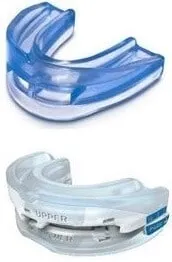
The second type of device known to be effective at stopping snoring is a MAD or Mandibular Advancement Device. These work by holding the lower job in place in a forward position.
In the same way that gravity allows the tongue to fall backward to obstruct the airways, so the jaw can also drop down onto the chest, having the same obstructing effect, especially in those who prefer to sleep on their back.
A MAD moves the jaw forward, preventing the constriction of the airways occurring.
Fitting Process
In the majority of cases, MAD devices use “boil and bite” technology in their fitting process. This involves putting the device in boiling water to soften the components which allow the product to be molded into the correct shape for your jaw.
The device is then removed from the water and allowed to cool a little before being inserted into the mouth whereupon the wearer bites down, allowing the material to mold to the shape of the gums or teeth. When a MAD is well fitted, it will deliver an excellent level of snoring prevention, encouraging the wearer to bite down in order to create tension in the jaw to hold it in the correct place.
What to Expect
When first starting to wear a MAD, it can take a little time for the jaw to get used to the sensation, so some soreness is common. Luckily, this subsides rapidly, and after a while, you will forget that you are wearing it.
Modern MADs offer a high-quality fit and are equipped with excellent features to ensure a pain-free and noiseless sleep. Features such as micro-adjustment or fine-adjustment are now often available, as well as visible measurement scales, allowing the wearer to easily track their adjustments.
MADs are also effective at preventing night time teeth grinding, as an added bonus. It is not necessary to visit your dentist in order to obtain an MAD, and indeed the ones available from the dentist are very expensive. Today, you can buy modern alternatives online which allow you to obtain a custom-fit in your own home.
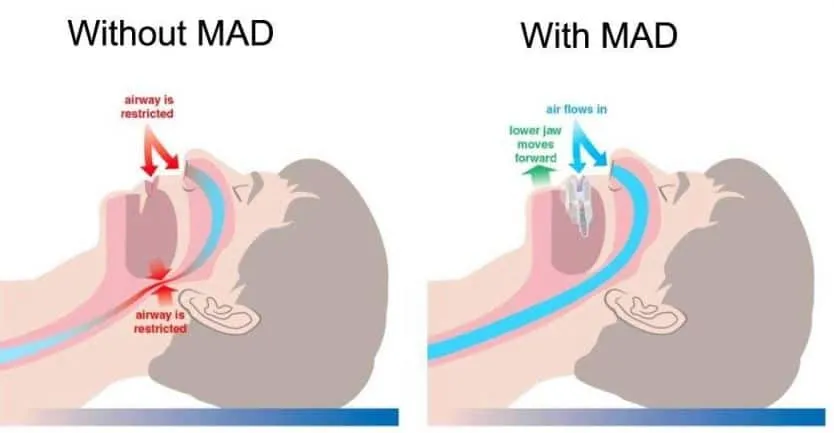
Top Anti-Snoring Mouthpieces
Good Morning Snore Solution

The Good Morning Snore Solution is a Tongue Stabilizing Device, not a MAD, and this sets it apart from most of the other available products.
This device works well to eliminate snoring while being a comfortable and safe solution. Suitable for denture wearers, those who dislike the feel of wearing a device inside their mouth, and for those with loose teeth, the GMSS works even for heavy snorers by keeping the tongue in the right position during sleep to prevent it from falling back into the throat and causing an airway obstruction which results in the tissue vibrations that cause snoring.
Its soft, non-bulky material feels comfortable inside the mouth, and as it is free from BPA it promotes better health and well being. The design is simple and easy to clean, enjoying a long lifespan of at least 12 months, and as it has been FDA cleared, the wearer can be assured of its safety. Simple to use, the GMSS can be worn straight out of the box with no need to adjust and it will not aggravate TMJ, unlike many rival products. As no prescription is necessary to purchase this device, the GMSS is a very convenient option.
Vital Sleep
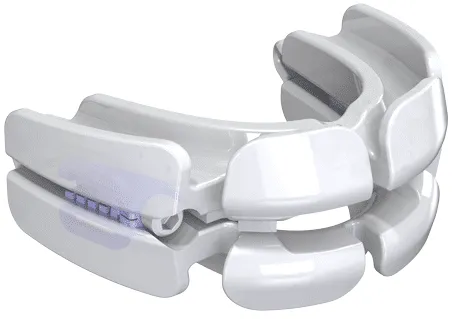
The VitalSleep is a Mandibular Advancement Device which has been cleared by the FDA and which has been designed to keep the lower jaw securely held in the correct forward position in order to prevent obstructions to the airways that result in the vibrations that cause snoring. Manufactured from USA-made thermoplastic, the VitalSleep is free from BPA and latex and is supplied in 2 sizes.
It uses the boil and bite technology so that the wearer can achieve the perfect fit, while the integrated Hex tool allows even greater customization to ensure the wearer’s complete comfort. This device also features a large air hole which enables users to breathe more naturally through their mouth while they sleep – ideal for those who struggle to breathe through their nose due to allergies, medical conditions or injury.
This product is suitable for anyone who wears partial dentures, and as an added bonus, it can help to guard against tooth grinding during the night. The VitalSleep is comfortable to wear, and thanks to its ability to allow side-to-side jaw movements, the strain on the lower jaw is reduced allowing a more natural feel to be achieved.
Zyppah
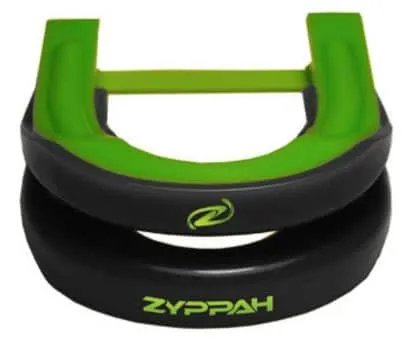
The Zyppah stop snoring device features an unusual and innovative design, and, with its vibrant coloring, it is visually appealing. This MAD device, which was designed by a qualified dentist, works by keeping the jaw securely held in the forward position while also featuring a stabilizing strap which stops the tongue from falling back during sleep and blocking the airway.
The Zyppah has been FDA cleared and uses the boil and bite technology to achieve a customized fit for the wearer. Safe to use, this hybrid solution combines both TSD and MAD technology to effectively stop snoring.
Light and small, it does not have a bulky feel in the mouth like many of its rivals, yet thanks to its robust construction, it boasts a long lifespan of up to 12 months. The integrated air holes allow the wearer to breathe naturally through either the nose or mouth during sleep, and as it is free from BPA, it promotes better health and wellbeing. It is also available in a choice of colors to suit the wearer’s preferences.
SnoreRx
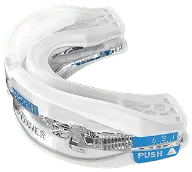
The SnoreRX is a MAD device which consists of a copolymer mouthpiece that is molded to the correct shape for the wearer through the boil and bite technology. Designed by an American neuroscientist to Medicare standards, this product is free from latex and BPA for better user safety and its in-built Flex-Jaw measurement unit helps the wearer to keep track of their adjustments and to achieve the best possible personalized fit. Soft and durable, this device will cause no irritation or pain to the gums and as it has been FDA cleared, users can rest assured of its safety.
The SnoreRX features integrated air holes allowing for more natural breathing during the night while the cushioned tray helps to protect teeth from grinding during sleep. This device is certified by the American Academy of Sleep Medicine and it enjoys a long lifespan of up to 15 months – longer than many rival products. Unlike many of its competitors, it is also designed not to aggravate Temporomandibular Joint Disorder while its ability to allow lateral jaw movements ensures the wearer’s best possible comfort at bedtime.
Zquiet
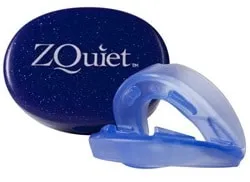
The ZQuiet is a MAD device that is free from BPA and latex for the wearer’s safety. Known to be effective at reducing or eliminating snoring, this device works by ensuring the lower jaw remains held securely in the correct forward position during sleep to keep the jaw muscles and throat tissues tight in order to reduce the vibrations which cause snoring. This device also stops the tongue from obstructing the airways and, as a bonus, it also helps improve the wearer’s breathing , ensuring the body stays optimally oxygenated. Made from a thermoplastic elastomer, the ZQuiet feels comfortable and soft when worn, and thanks to the integrated airflow posts and Living Hinge technology, the wearer can enjoy a more natural sleep experience. Easy to adjust to the correct shape and size with scissors, this product comes in two sizes and requires no molding, unlike many other similar products. It is also easy to clean and boasts a long lifespan. Made in the USA, the ZQuiet is approved by the FDA and has been designed by a sleep specialist, so purchasers can rest assured of the safety and effectiveness of this product.
Pure Sleep
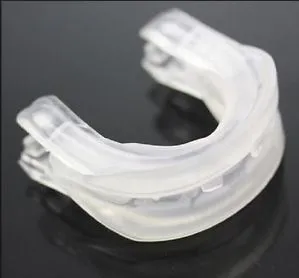
PureSleep is a two-piece MAD stop snoring device which keeps the jaw held forward into the correct position during sleep in order to stop the tongue falling backwards into the throat and obstructing the airways. Unlike the majority of MAD devices, the PureSleep is a little different, being made of two pieces instead of a single piece. The upper and lower pieces are connected with 3 possible settings and this controls how far forward the lower jaw is pushed. Using boil and bite technology, it is possible to achieve a customized fit so that the device is comfortable to wear. Cleared by the FDA, this device is manufactured in America and contains no BPA or latex for the wearer’s safety. It also has integrated airflow holes to allow the wearer to breathe naturally through their mouth during the night. The PureSleep MAD device lasts for up to 9 months before requiring replacement.
My Snoring Solution
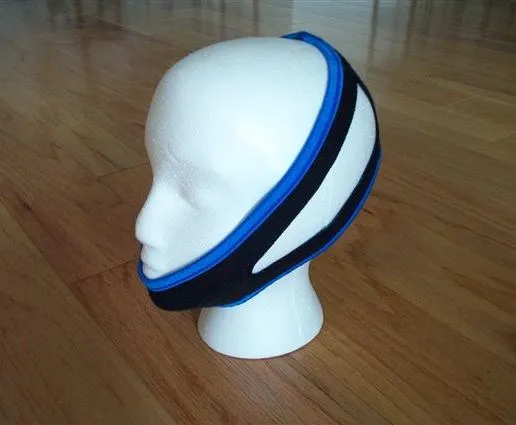
My Snoring Solution takes the form of a headband which supports the jaw during sleep. It is manufactured from a stretchy, flexible material that is worn around the head to encase it while the wearer sleeps. The chin is placed in the wide part of the headband and then the rest of the band stretches over the ears and the back of the head. It works by forcing the jaw gently forward and up, allowing the wearer to breathe naturally while resetting the muscle tissues of the throat. By keeping the mouth closed, it opens the airway passages automatically, reducing air velocity and preventing vibrations in the soft tissues that cause snoring. One size fits all, and it is suitable for most people, even those who wear dentures. This is a good product for anyone who dislikes the feel of a device inside their mouth while they sleep, and it is also very easy to use. Over time, it trains the jaw to move forward, meaning that eventually the device will no longer be required, and as it does not affect the tongue, teeth or gums, it causes no drooling or pain, unlike some other stop snoring devices.
Characteristics To Examine Before Buying
It can be hard to know which anti-snoring device is right for you, so here we look at the different characteristics that you should consider when choosing between products.
Material
The quality and type of material used in the manufacture of your device is very important. You should ensure that it contains no BPA (Bisphenol A) which has been associated with liver problems, heart disease, cancer, erectile dysfunction and diabetes, as well as problems with brain and hormone development in children and fetuses.
BPA enters the body via the skin, and since you will be wearing your oral device all night long, it is best avoided. You should also check to see if your chosen device contains latex, especially if you know that you are one of the 3 million people in the country with an allergy to this material. The best material to choose is dental thermoplastic, which is used in the manufacture of professional produced mouth appliances and dentures.
Comfort and Adjustability
The more you are able to adjust your device, the more you will find it comfortable to wear, and comfort should be a key priority. It is pointless to choose a device that is so painful to use that it makes your sleep even worse.
TSDs do not need to be adjusted, however an MAD will benefit from incremental adjustability and boil and bite technology to allow for the most customized fit. Devices which incorporate boil and bite technology can often be remolded numerous times, allowing for you to maintain and excellent fit over the long term.
Although you could also choose a dental impression kit, these are more expensive. When choosing this option, you are sent a tray and molding clay by the manufacturer. You apply the clay to the tray and bite down leaving the impression of you teeth. The kit is then returned to the manufacturer who produces an oral devices customized to your own jaw. While these ensure a precise fit, they can take many weeks to arrive.
Boil-and-Bite Customization
Mouths are like snowflakes, and no two are alike. As such, if you decide to go with a MAD, it is important that it will be allowed to conform to your mouth’s exact shape. This can be achieved with the majority of devices that are on the market today with the technology known as “boil and bite.” You simply bring a pot of water to a boil and drop the device in. The boiling water will soften the material and then you take it out and let it sit and cool down to a temperature that is safe. Once it has cooled, place the device in your mouth then bite down.
The firm pressure of your bite will allow it to be customized for your gums and teeth. Some people have claimed the device can be remolded 5 times, which is an important aspect of the product. Because the more the device can be remolded, the better for you since many people’s mouths change over time.
For a thorough customization, there are dental impression kits on the market too, which are a bit more expensive. The manufacturer of these MADs will send you a mouth tray with enough molding clay to get an exact impression on the tray of your teeth.
After you have your impression on the tray, you mail the kit back to the manufacturer, and they will produce an oral device that is a customized fit for you. This allows you to get that precise fit, but the downside is the turn-around time can take a few weeks to receive your final product.
Breathing holes vs no breathing holes
Not every device features a breathing hold, and not every snorer requires one. If you have a medical condition restricting your airflow such as a sinus problem, you would probably benefit from a mouthguard that has a breathing hole. These are also a good choice for those who sleep with their mouths open.
It is important to keep in mind the size of the breathing hole, as one which is too small prevents enough air from reaching the lungs and once which is too big can force the mouth into a position that is not comfortable. A breathing hole can also produce whistling noises and may result in a dry throat and mouth.
Life expectancy of the stop snoring mouthpiece
It is important to have realistic expectations when buying an anti-snoring mouthpiece with regards to its lifespan. Remember that you will be wearing it for up to a third of each day and therefore it may need to be replaced relatively frequently.
Most products last between 6 and 12 months, although some require replacement more frequently, around every 3 months. In these cases, cost can be a factor and therefore choosing a produce which has a longer lifespan and yet is a little more expensive could be better value in the long run.
If you have a shorter period of sleep every night, your device will probably last longer, however if you grind your teeth during the night, you will probably need to replace your device more often.
Value and Affordability

Although a cheaper product may be appealing, if it has a short lifespan or is very uncomfortable to wear, it is false economy. Be prepared to spend a little more on a quality device as this is better value for money.
Devices generally cost between $35 and $200, however if you buy one from your dentist, the price will be a lot higher. Although cost is an important factor, it is not the be-all and end-all of your decision.
While you may not require the most expensive device on the market, you should choose one which the right features to accommodate you and your snoring problem effectively.
Things You Should Know
You probably have many questions in your mind when you are ready to choose the right anti-snoring device for you, so here we address some of the main queries which commonly arise.
Why do people snore?
In the center of the soft palate you will find the uvula, a conical-shaped projection. If the tissues of the throat make contact with this projection it causes the airway to become obstructed, resulting in vibrations and snoring sounds.Snoring may also be caused by failure to inhale enough air with each breath. Some people snore because they are in a very deep sleep through taking sleeping pills or drinking alcohol. Some people are nasal snorers, a problem caused by several conditions from obesity or enlarged tonsils to nasal polyps or a deviated septum.
How does an MAD work?
MADs can reduce or prevent snoring by holding the jaw in a forward position. Placed between the lower and upper teeth, it tightens the muscles and tissues in the upper airways, and prevents gravity from pulling the jaw downwards towards the throat where the airways can be constricted. MADs are simply placed in the mouth before sleep and are a popular anti-snoring solution in the UK, USA and Canada.
How does a TSD work?
Similar in approach to an MAD, a TSD fits over the tip of the tongue, holding it in position. Usually, it works by squeezing a bulb on the device before positioning the tongue against it and releasing the bulb to create a vacuum that keeps the tongue in place, preventing it from falling into the throat and blocking the airways. Usually, these devices feature tabs which protrude from the lips, keeping the device and tongue in the correct forward position. While they are not as popular as MADs, they are equally effective at preventing snoring and are a less intrusive solution.
How long do stop snoring mouthpieces last?
The life expectancy of an oral device can vary, but usually, their lifespan is around six to 18 months. However, each individual’s sleeping habits will have an effect on the life expectancy of the device. For example, those who grind their teeth will find they have to replace their device more frequently. A custom fitted device obtained through a dentist will have a long lifespan, often of several years.
Can anti-snoring mouthpieces be worn with dentures?
A TSD is an effective solution for snorers who have dentures as they do not have to be bitten down on to stay in place and therefore require no teeth to wear it.MADs are not a good choice for denture wearers as they require the wearer to bite down. While some devices are denture-compatible, they require the wearer to keep their dentures in at night.
Will a MAD make my mouth sore?
Many people experience discomfort in their face and jaw when they begin wearing an MAD, due to the tension in the muscles and jaw. This is the typical soreness associated with working the muscles in an unusual way and after around 3-7 days, this feeling will subside.
Will it help with teeth grinding?
One of the best things about stop snoring mouthpieces is that they work for both teeth grinding and snoring. By being positioned between both sets of teeth, these devices prevent the damage that can be caused by night time grinding.
Do I need a prescription to order snore guard?
Both MADs and TSDs are Class II Medical Devices (as classified by the FDA) and therefore you need a prescription to order one. However there is a way of getting around this and you require no prescription to order one online.
Can I breathe through my mouth while wearing my stop snoring device?
As long as you choose a mouthpiece that features a breathing hole you will find that you can breathe through your mouth as normal. If your device does not have a breathing hole however, you will not be able to. Make sure you choose a breathing hole in the right size, as one that is too small will limit your airflow while one that is too big will keep your jaw held wider than it should be.
How do I clean my MAD or TSD?
Keeping your oral device clean an disinfected is vital for your health. Luckily, both MADs and TSDs are simple to look after. You can clean most devices with a toothbrush and toothpaste, however some require you to use a particular cleaning solution, so you should pay attention to the care instructions from the manufacturer.The amount of effort put into keeping your device clean could be an important factor to bear in mind when making your choice of product – remember that if there are lots of nooks and crannies in the device it will harbor more bacteria and therefore need a more complex cleaning regime.
Is it possible to swallow it while sleeping?
Any product approved by a government regulating service like the Therapeutic Products Directorate in Canada or the FDA in the USA is considered to be safe and therefore should not be a choking hazard, and while it is not 100% guaranteed, it should not cause you any problems.
Spoiler title
The “Boil and Bite” method is often used to create a customized fit in anti-snoring devices. It works by putting the device into boiling water which allows the materials to soften. Once it has been removed and cooled to a safe temperature, it is then put into the mouth and the wearer bites down to form an impression of their jaw in the material. Once it has cooled and hardened, it molds into the shape of the wearer’s teeth. Devices which use this technology are less costly than those which have dental impression kits. A dental impression kit uses clay in a mouth tray, which the user bites into and then sends to the lab where the device is made professionally.
How effective are stop snoring mouthpieces?
There is no definitive answer to this question. Some of the product’s manufacturers make claims of 94%, 96% or 98% effectiveness, and the general satisfaction rate appears to be described as “90%+”. You should be aware that there is a difference between satisfaction rate and a product’s effectiveness, and to find the most accurate estimate you should look at trustworthy medical research.A study in Belgium showed that 65% of snorers who used a low cost MAD device experienced improvement in their condition, with the conclusion that using a mouthpiece is a feasible solution to snoring and using a cheap MAD at first could determine how effective it was going to be before purchasing a more expensive custom-made device. There are also other studies which show an higher rate of success.
Is it okay for children to use these devices?
Mouthpieces are not recommended for use by children as they can interfere with the proper development of the jaw and teeth.
Spoiler title
In the majority of cases, a boil and bite device can be remolded 2 or 3 times, so there is no need to worry if you fail to get the perfect impression the first time. You should note, however, that each time you remold the material it will break down a little, and although some manufacturers state that their device can be remolded up to 5 times, this may be a bit of a stretch.
What does it mean for a device to be cleared by the FDA?
If a snore mouthpiece is cleared by the FDA it is considered safe to use. The FDA takes responsibility for thorough testing on drugs, foods, cosmetics, biological products, medical devices and many other products for the purpose of protecting public health.
If I have TMJ can I use a mouthpiece?
TMJ or Temporomandibular Joint Disorder is caused by several things including grinding and clenching of the teeth, a misaligned bite, wear and tear to the cartilage, arthritis and dislocation. It results in pain in the teeth, ear and joint of the jaw.As the symptoms and causes of this condition are related to the jaw and mouth, it is advised that sufferers do not use MAD devices. However a TSD is often a suitable solution for TMJ sufferers, as long as you ask your medical practitioner for their advice before making your purchase.
Why am I being asked to fill out a questionnaire when purchasing online?
Many manufacturers will ask you to complete some questions about your oral health before you make your purchase in order to ensure that the product is suited to your needs.Not only are they helping to look out for you, but they are also protecting themselves legally. You should always answer the questionnaire truthfully as it is in both yours and the manufacturers best interests.
Are these anti-snoring devices safe to use?
Both TSDs and MADs are considered safe to use as long as it is under the following conditions.
- It is only used for its intended purposes and according to the instructions supplied by the manufacturer.
- It has been approved for use by the FDA or another trusted regulatory body.
- You do not have TMJ, loose teeth, gum disease or a medical condition that could be made worse by the use of the device.

Patrick Mahinge
Patrick Mahinge, the chief editor at MTBNZ.org is a serial webpreneur who also enjoys mountain biking.
Related Articles

27-07-2018
Dream Interpretation and Analysis: What Do Your Dreams Mean
Read more about this article...
Read more →

28-10-2019
How to Reset Your Body Clock Fast And Get Better Sleep Every Day
Read more about this article...
Read more →